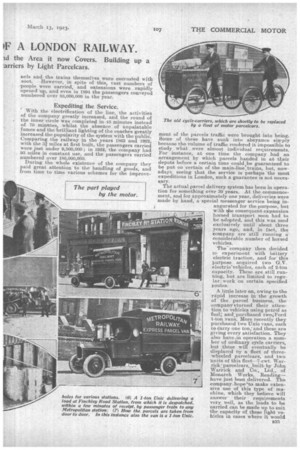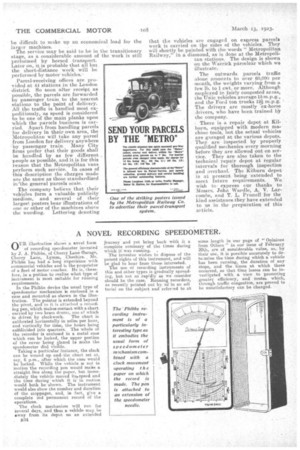THE PARCELVAN SERV A LONDON RAILWAY.
Page 20

Page 21

Page 22

If you've noticed an error in this article please click here to report it so we can fix it.
How the Parcel Delivery System was Inai4 Composite Fleet. Rep lad ld the Area it now Covers. Building up a :arriers by Light Parcelcars.
DURING a, recent journey across London our. attention was attracted by a,striking poster, issued by the Metropolitan Railway, pointing out the 'advantages of the express parcel delivery system operating over the area covered by their lines. The prices quoted for the carriage of parcels appeared to us to be so reasonable that we determined to visit the offices of the company for the purpose of inquiring into the methods utilized for conveying the goods.
While dealing With this parcels service, it may be of interest to our readers to give a leis-trine of the development ot, the Metropolitan Railway. It was only last month that the company celebrated their diamond jubilee. When the 'bid was opened—in January, 1863 —the streets were in an almost impassable state. It often took longer to cross the City in a horsed vehicle (and at that time there were, no others) than to travel by train to Brighton or Oxford, and often quantities of heavy goods were still regularly dealt with at the old coaching office depots in the main streets, whilst' the thoroughfares were blocked by hundreds of horsed omnibuses, arid it. was to rid the streets of some of this traffic, and thus enable people to move with greater freedom, that.the promoters of the North Metro
a32 polita,n Railway inaugurated their first section of line between Bishop's Road, Paddington, and Far-, ringdon Street, a distance of 31 miles. At that time it was expected that the line would carry more goods traffic than passengers;Thut soon it was realized that the reverse would be the case.
Difficulties Overcome.
Many difficulties had to be overcome before the first section of the railway'was actually working. One of the greatest was the bursting of the Fleet Ditzt sewer, which caused enormous damage in Farrin'gdon Street, and filled the tunnels 10 ft. deep so far as King's Cross. The tunnels were encased in rings of bricks, eight thick, and these are as firm now as they were when first built—well over half a:century ago.
Some of our readers will no doubt remember, as does the writer, the stifling feeling which was experienced while travelling on the old Metropolitan. Although said to be healthy, the sulphurous fumes were very disagreeable, and,the interiors of the tun nels and the trains themselves were encrusted with soot. However, in spite of this, vast numbers of people were carried, and extensions were rapidly opened 'up, and even in 1894 the passengers conveyed numbered over 88,000,000 in the year.
Expediting the Service.
With the electrification of the line, the activities of the company greatly increased, and the round of the inner circle was completed in. 48 minutes instead of 70 minntes, whilst the absence of unpalatable fumes and the brilliant lighting of the coaches greatly increased the popularity of the system with the public. Comparing the railway in the years 1863 and 1922, with the at miles at first built, the pa,ssengers carried were just under 9,500,000; in 1922, the company had 93 miles in constant use, and the passengers carried numbered over 180,000,000. During the -whole existence of the company they paid great attention to the handling of goods, and from time to time various schemes for the improve
merit of the parcels traffic were brought into being. Some of these have sunk into abeyance simply because the volume of traffic rendered it impossible to study what were almost individual requirements. instance, nstance, at one time the company had an arrangement by which parcels handed in at their depots before a certain time could,he guaranteed to be put on certain of the main-line.trains, but, nowadaya.. seeing that the service is perhaps the most expeditious in London, such a guarantee is not necessary.
The actual parcel delivery system has been in operation for something over 30 years. At the commencement, and for approximately one year, deliveries were made by hand, a special messenger service being inaugurated for the purpose, but with the consequent expansion horsed transport soon had to be adopted, and this was used exclusively until about three years ago, and, in fact, the Bompany are still rimning a, considerable number of horsed vehicles.
'The—company then decided to experiment with battery electric traction, and for this r,ur p o so acquired two G.V. electridvehieles, each of 2-ton capacity. These are still running, but are limited to regular; work on certain specified 'routes.
A little later on, owing to the rapid increase in the growth of the parcel business, the company turned their attention to vehicles using petrol as fuel; andAmrchased twoiFord t-ton vans. More recently they purchased two Vide vans, each to carry one ton, and these are giving every satisfaction. They also have .in operation a number of ordinary-cycle carriers, but these will eventually be displaced ny a fleet of threewheeled parcelcars, and two units of this fleet-7-cwt. Warrick • parcelcars„built. by John Warrick and Co., Ltd., of Monarch Works, Reading— have just been delivered. The company ,hope 'to make extensive use of this type of machine, which they believe will answer their requirements very. well, as the loads to be carried can he made up to suit the capacity of these light vehicles in cases where it would
be difficult to make up an economical load for the larger machines.
Parcel-receiving offices are provided at 44 stations in the London district. So soon after receipt as possible, the parcels are forwarded by passenger train to the nearest stations to the point of delivery. All the traffic is handled most expeditiously, as speed is considered ts he one of the main planks upon Which the parcels business is carried. Apart from handling parcels for delivery in their own area., the Aletronolitan will take any parcel from London for delivery anywhere by passenger train. Many City firms prefer that their goeds shall be handled by as few different people as possible, and it is for this reason that the Metropolitan vans perform such service. In .cases of this description the charges made are the same as those standardized in 'the general parcels scale.
The company believe that their vehicles form a valuablepublicity medium, and several of their largest posters bear illustrations of one or other of the Machines above the wording. Lettering denoting that the vehicles are engaged on express parcels work is carried on tbe sides of the vehicles. They will shortly be painted with the words " Metropolitan Railway," in a diamond, as is done at. the Metropoli tan stations. The design is shown on the V. arrick parcelear which we illustrate.
The outwards parcels traffic alone amounts to over 60,000 per month, the weights varying from a few lb. to 1 cwt. or more. Although employed in fairly congested areas, the Unie vehicles average 15 and the Ford ton trucks 12 in:p.g. The drivers are mostly -ex-horse drivers, who have been. trained bY the company.
• There is a repair depot at Kilburn, equipped with modern machine tools, but the actual vehicles are garaged at the various depots. They are inspected by properly qualified mechanics every morning before they are allowed out on service. They are also taken to the technical repair depot at regular intervals for thorough inspection and overhaul. The Kilburn depot is at present being -extended to meet future requirements. We wish to express cur thanks to -Messrs. John Wardle, A. V. Larcombe, and T. L. Prunell for the kind assistance they have extended to us in the preparation of this article.
































